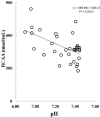Increase in branched-chain amino acids due to acidemia in neonatal calves with diarrhoea
- PMID: 29177054
- PMCID: PMC5687547
- DOI: 10.1136/vetreco-2017-000234
Increase in branched-chain amino acids due to acidemia in neonatal calves with diarrhoea
Abstract
The aim of this study was to investigate the relationships between acid-base status and plasma branched-chain amino acids (BCAA) concentration in calves with diarrhoea for intravenous nutrition, especially with amino acid solution in calves with diarrhoea. Thirty-four Holstein calves aged 11.0±5.9 days old were enrolled in this study. In 10 of 34 calves exhibiting clinical signs of diarrhoea, severe dehydration and acidemia were observed (severe group: pH: 7.04±0.11, base excess (BE): -17.4±4.5) based on blood gas analysis. In 7 of 34 calves exhibiting clinical signs of diarrhoea, mild dehydration and acidemia were observed (mild group: pH: 7.29±0.06, BE: 0.0±5.2). The other 17 calves did not exhibit dehydration or acidemia (pH: 7.41±0.02, BE: 11.2±3.5) based on clinical signs and blood gas analysis. The plasma concentration of BCAA was significantly higher in the severe group than in the other groups. In addition, the blood pH and plasma concentrations of BCAA (r=-0.41, P<0.05) were significantly and negatively correlated. As calves with metabolic acidosis have increased plasma BCAA concentrations due to hypermetabolic states of proteolysis, amino acid solutions containing low concentrations of BCAA may be useful to gradually correct the negative nitrogen balance.
Keywords: acidemia; amino acids; branched chain amino acids; calf; diarrhea.
Conflict of interest statement
Competing interests: None declared.
Figures


Similar articles
-
Plasma amino acid abnormalities in calves with diarrhea.J Vet Med Sci. 2019 Apr 16;81(4):517-521. doi: 10.1292/jvms.18-0645. Epub 2019 Feb 12. J Vet Med Sci. 2019. PMID: 30745526 Free PMC article.
-
Effects of profound acidemia on the dynamic glucose and insulin response and plasma potassium and phosphorus concentrations during an intravenous glucose tolerance test in neonatal calves.J Dairy Sci. 2017 Nov;100(11):9163-9176. doi: 10.3168/jds.2017-12690. Epub 2017 Sep 6. J Dairy Sci. 2017. PMID: 28888605 Clinical Trial.
-
Effect of dehydration and acidemia on the potassium content of muscle tissue and erythrocytes in calves with neonatal diarrhea.J Dairy Sci. 2018 Oct;101(10):9339-9349. doi: 10.3168/jds.2018-14790. Epub 2018 Aug 9. J Dairy Sci. 2018. PMID: 30100512
-
Effects of branched-chain amino acids on protein turnover.Diabetes Metab Rev. 1989 May;5(3):227-45. doi: 10.1002/dmr.5610050303. Diabetes Metab Rev. 1989. PMID: 2656154 Review.
-
Branched chain amino acid therapy in liver disease.J Am Coll Nutr. 1985;4(6):639-50. doi: 10.1080/07315724.1985.10720106. J Am Coll Nutr. 1985. PMID: 3935706 Review.
Cited by
-
Plasma amino acid abnormalities in calves with diarrhea.J Vet Med Sci. 2019 Apr 16;81(4):517-521. doi: 10.1292/jvms.18-0645. Epub 2019 Feb 12. J Vet Med Sci. 2019. PMID: 30745526 Free PMC article.
-
Hypoglycemia and failure of respiratory compensation are risk factors for mortality in diarrheic calves in Hokkaido, northern Japan.J Vet Med Sci. 2018 Jul 18;80(7):1159-1164. doi: 10.1292/jvms.18-0109. Epub 2018 Jun 4. J Vet Med Sci. 2018. PMID: 29863028 Free PMC article.
-
Amino Acid-Based Diet Prevents Lethal Infectious Diarrhea by Maintaining Body Water Balance in a Murine Citrobacter rodentium Infection Model.Nutrients. 2021 May 31;13(6):1896. doi: 10.3390/nu13061896. Nutrients. 2021. PMID: 34072947 Free PMC article.
References
-
- Sabine JR, Johnson BC. Acetate metabolism in the ruminant. J Biol Chem 1964;239:89–93. - PubMed
-
- Berchtold J, Foster DM, Smith GW. Treatment of calf diarrhea: intravenous fluid therapy. Vet Clin North Am Food Anim Pract 2009;25:73–99. doi:10.1016/j.cvfa.2008.10.001 - DOI - PMC - PubMed
-
- Youanes YD, Herdt TH. Changes in small intestinal morphology and flora associated with decreased energy digestibility in calves with naturally occurring diarrhea. Am J Vet Res 1987;48:719–25. - PubMed
-
- May RC, Hara Y, Kelly RA, et al. . Branched-chain amino acid metabolism in rat muscle: abnormal regulation in acidosis. Am J Physiol 1987;252:712–8. - PubMed
-
- Kooman JP, Deutz NEP, Zijlmans P, et al. . The influence of bicarbonate supplementation on plasma levels of branched-chain amino acids in haemodialysis patients with metabolic acidosis: official publication of the european dialysis and transplant association. ndt 1997;12:2397–401. - PubMed
LinkOut - more resources
Full Text Sources
Other Literature Sources
Research Materials

